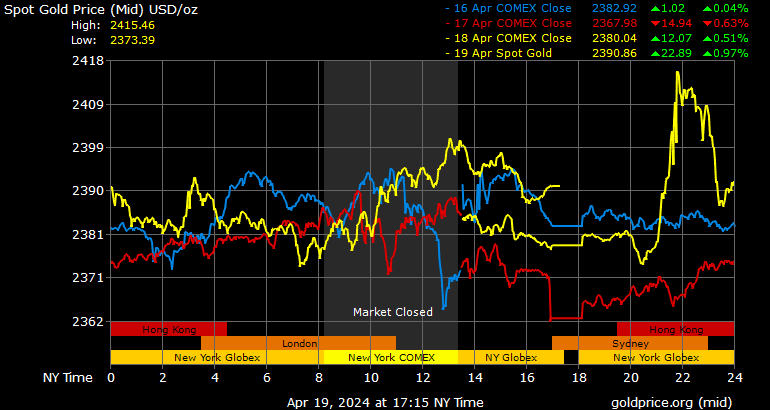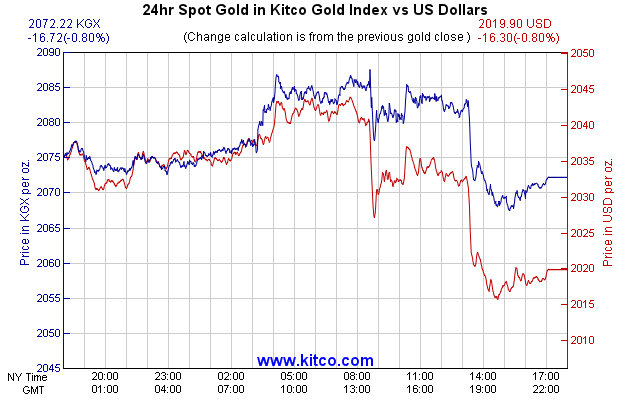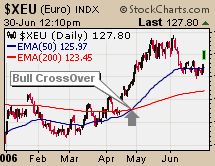In an interview with Louis James, John Hathaway discusses the US’s economic outlook and why he’s delighted by the current bearish sentiment toward gold.
[To be a successful speculator, one must be willing to go against the mainstream investment trends, as John is. There's no better way to get a primer on contrarian investing than by sitting in on the recently concluded Casey Research Recovery Reality Check Summit – and you can do that by ordering the Summit Audio Collection today. Every presentation, every chart and graph, and every actionable investment tip can be yours, in either the instantly available MP3 files, or in CD format.]
Louis James: Ladies and gentleman, thanks for tuning in. We’re at the Casey Research Recovery Reality Check Summit. We’re talking with John Hathaway, one of the more successful fund investors – institutional investors – in our precious metals field near and dear to my heart. John, can you give us a quick version of what you talked about here, for those who didn’t make it to the conference?
John Hathaway: Sure, yes. I think we’re at the end of a correction that resulted from the peak last summer. It was overcooked, kind of hyperventilated hysteria over the debt-ceiling talks, the rating downgrade of the US sovereign debt, and I think basically the stocks and the metal had been working off that boiled down to what we now have is a simmer. I think we are at a position where there’s not a lot of downside, and I would not be surprised by revisiting the previous highs of $1,900 and maybe even new highs over $2,000 this year.
What will do that is basically – so much of the narrative has been quantitative easing. When Bernanke announced on the 29th of February that they were done with quantitative easing (and if you believe that I’ve got a bridge to sell you, but for the time being let’s assume that there won’t be any), I was very impressed that gold did not go to a new low. It printed somewhere below $1,600 at the end of the year, made a couple-of-day swoon, but it didn’t go to a new low. And then when the Fed minutes came out it also did not go to a new low, it kind of reiterated what Bernanke said. So the narrative may be changing. I’m not ruling out quantitative easing as a possibility, but there are things out there that gold might be looking at that the CNBC mentality hasn’t figured out.
Remember that gold rose for many years before we even heard of quantitative easing; it was in a steady uptrend. So what could those things be? What would take gold – what would be the new headlines that might take gold to higher highs? To me, the biggest thing is that the Federal Reserve has purchased something like 61% of all new Treasury debt in the last year; and if they aren’t going to continue that, then what’s going to happen to rates?
Louis: Right.
John: The Chinese – who had been big supporters because they were rigging their currency – have not been generating foreign exchange to anything like the extent they were, so their participation rate in Treasury auctions has gone way down. If you look up the TIC numbers, foreign buying of Treasuries has dropped precipitously, so you have the two biggest pillars of support for keeping rates low in question here, and let’s see what happens on June 30th. If you don’t have a political buyer, either the Chinese and foreign buyers who are manipulating currency, and the Fed because they said they aren’t going to do it, what are rates going to do?
If you are going to get a risk-free return inflation-adjusted today that’s not politically motivated, it’s got to be somewhere around 4-5% on the short end of the curve. Every hundred basis points adds a huge amount to the budget deficit, so to me we’re in a real trap here, where it’s going to be a game of chicken as to whether the Fed can really live up to what Bernanke said on the 29th.
Louis: Isn’t that really the bottom line? They can’t allow that interest rate to rise with the debt outstanding –
John: It seems very difficult. The recovery, the alleged recovery that we had, is very… I’ll grant that things are better than they were a year ago or two years ago, but you’d have to call it feeble at best and maybe not sustainable. That’s one thing that I think could affect the gold market.
The second thing, and I think it’s very important too, is that inflation is rising. Even though the economy is soft, the number I look at – and I know we’re going to have John Williams speak at lunch, and we know he has a very good take on it – is the MIT Inflation Index, because that’s real-time pricing of billions of products. You can get to that website just by googling “MIT Inflation Project”; and that does not include services. Most of the services I take are inflating at more than 5%; they are closer to 10%. But goods that could be measured in real time are rising at 5%, so that’s also going to be a factor. That means if rates stay where they are, the Feds are just going to be that much more behind the curve.
So those are two things; and the third thing is that there’s $1.5 trillion of liquidity in the system that should the recovery – and I’m not a macro forecaster, but let’s say the recovery does sustain itself – you’ve got $1.5 trillion of free reserves that could just turn into money supply. Then you really would have a potentially hyperinflationary scenario, and the Fed would be completely powerless to do anything about it. So I think that’s bullish for gold – gold is not backward looking, it basically looks forward. I can go on and on. You’ve got the European unresolved sovereign debt crisis in Europe.
Louis: Let me jump in with a question about this, then. You’ve stood out really from the crowd in that most people agree on the general prognosis for gold. Most people are sort of near-term bearish, you know, the ones –
John: It makes me so happy.
Louis: [Laughs] But, you know, once a bear sentiment sets in, it seems to almost have its own momentum.
John: Yes.
Louis: You’re the only who’s saying “I think we’re near the bottom.” Most people are saying, “Sell in May and go away” –
John: Yes, I heard a couple of things from this session that just made me want to jump up and buy –
Louis: I understand the contrarian reason for that, but can you tell our audience a couple of reasons why you think we might be near the bottom or why you’re ready to buy now and not waiting to see how this summer turns out?
John: Sure. Well, first of all, I’m not a trader. I mean, I’m long, and last summer I thought, “Gee, this is really a little spooky, we’re not at a sustainable level,” but there wasn’t a whole lot I could do about it. And here we are and we have some cash, we have some inflows, so we are able to put money to work. And what is it that makes me think we’re there? Sentiment numbers are extremely negative, historically, when they’ve gotten to these levels. By the way, I put out a quarterly newsletter now that has a lot of this data, which can be found on our website.
Louis: Go ahead and give us the website.
John: It’s the Tocqueville Asset Management website, and it should be fairly easy to find. So sentiment is at levels that have been associated with big rallies. Traders’ commitments, net longs, net spec longs are way, way down there. I look at that a lot just as a way to see where the market is positioned. The guys who can create some volatility are not there, and so if gold starts moving, they won’t want to miss it, and so they’ll come in. And then, we’ve looked at some technical stuff. I’m not a technician but most of what I see from a technical perspective is extremely constructive. So I put those things together.
Sentiment is rock bottom. COMEX traders’ commitments are very, very constructive, and technical things that we look at are very constructive. So I would say all of those things, plus hearing these guys say that they are not going to step in – that’s more anecdotal, but that to me is just very, very positive. So I – frankly I don’t stake my reputation the way that Dennis Gartman does on making trading calls, but just as an experienced observer of this market for some number of years now, I think we’re ready to make a move higher.
Louis: Okay, well, thank you very much. Word to the wise.
John: Thank you.
Comments : Ino.com
-------------------------------------
Paksu: Next support $1525, it's possible...
[To be a successful speculator, one must be willing to go against the mainstream investment trends, as John is. There's no better way to get a primer on contrarian investing than by sitting in on the recently concluded Casey Research Recovery Reality Check Summit – and you can do that by ordering the Summit Audio Collection today. Every presentation, every chart and graph, and every actionable investment tip can be yours, in either the instantly available MP3 files, or in CD format.]
Louis James: Ladies and gentleman, thanks for tuning in. We’re at the Casey Research Recovery Reality Check Summit. We’re talking with John Hathaway, one of the more successful fund investors – institutional investors – in our precious metals field near and dear to my heart. John, can you give us a quick version of what you talked about here, for those who didn’t make it to the conference?
John Hathaway: Sure, yes. I think we’re at the end of a correction that resulted from the peak last summer. It was overcooked, kind of hyperventilated hysteria over the debt-ceiling talks, the rating downgrade of the US sovereign debt, and I think basically the stocks and the metal had been working off that boiled down to what we now have is a simmer. I think we are at a position where there’s not a lot of downside, and I would not be surprised by revisiting the previous highs of $1,900 and maybe even new highs over $2,000 this year.
What will do that is basically – so much of the narrative has been quantitative easing. When Bernanke announced on the 29th of February that they were done with quantitative easing (and if you believe that I’ve got a bridge to sell you, but for the time being let’s assume that there won’t be any), I was very impressed that gold did not go to a new low. It printed somewhere below $1,600 at the end of the year, made a couple-of-day swoon, but it didn’t go to a new low. And then when the Fed minutes came out it also did not go to a new low, it kind of reiterated what Bernanke said. So the narrative may be changing. I’m not ruling out quantitative easing as a possibility, but there are things out there that gold might be looking at that the CNBC mentality hasn’t figured out.
Remember that gold rose for many years before we even heard of quantitative easing; it was in a steady uptrend. So what could those things be? What would take gold – what would be the new headlines that might take gold to higher highs? To me, the biggest thing is that the Federal Reserve has purchased something like 61% of all new Treasury debt in the last year; and if they aren’t going to continue that, then what’s going to happen to rates?
Louis: Right.
John: The Chinese – who had been big supporters because they were rigging their currency – have not been generating foreign exchange to anything like the extent they were, so their participation rate in Treasury auctions has gone way down. If you look up the TIC numbers, foreign buying of Treasuries has dropped precipitously, so you have the two biggest pillars of support for keeping rates low in question here, and let’s see what happens on June 30th. If you don’t have a political buyer, either the Chinese and foreign buyers who are manipulating currency, and the Fed because they said they aren’t going to do it, what are rates going to do?
If you are going to get a risk-free return inflation-adjusted today that’s not politically motivated, it’s got to be somewhere around 4-5% on the short end of the curve. Every hundred basis points adds a huge amount to the budget deficit, so to me we’re in a real trap here, where it’s going to be a game of chicken as to whether the Fed can really live up to what Bernanke said on the 29th.
Louis: Isn’t that really the bottom line? They can’t allow that interest rate to rise with the debt outstanding –
John: It seems very difficult. The recovery, the alleged recovery that we had, is very… I’ll grant that things are better than they were a year ago or two years ago, but you’d have to call it feeble at best and maybe not sustainable. That’s one thing that I think could affect the gold market.
The second thing, and I think it’s very important too, is that inflation is rising. Even though the economy is soft, the number I look at – and I know we’re going to have John Williams speak at lunch, and we know he has a very good take on it – is the MIT Inflation Index, because that’s real-time pricing of billions of products. You can get to that website just by googling “MIT Inflation Project”; and that does not include services. Most of the services I take are inflating at more than 5%; they are closer to 10%. But goods that could be measured in real time are rising at 5%, so that’s also going to be a factor. That means if rates stay where they are, the Feds are just going to be that much more behind the curve.
So those are two things; and the third thing is that there’s $1.5 trillion of liquidity in the system that should the recovery – and I’m not a macro forecaster, but let’s say the recovery does sustain itself – you’ve got $1.5 trillion of free reserves that could just turn into money supply. Then you really would have a potentially hyperinflationary scenario, and the Fed would be completely powerless to do anything about it. So I think that’s bullish for gold – gold is not backward looking, it basically looks forward. I can go on and on. You’ve got the European unresolved sovereign debt crisis in Europe.
Louis: Let me jump in with a question about this, then. You’ve stood out really from the crowd in that most people agree on the general prognosis for gold. Most people are sort of near-term bearish, you know, the ones –
John: It makes me so happy.
Louis: [Laughs] But, you know, once a bear sentiment sets in, it seems to almost have its own momentum.
John: Yes.
Louis: You’re the only who’s saying “I think we’re near the bottom.” Most people are saying, “Sell in May and go away” –
John: Yes, I heard a couple of things from this session that just made me want to jump up and buy –
Louis: I understand the contrarian reason for that, but can you tell our audience a couple of reasons why you think we might be near the bottom or why you’re ready to buy now and not waiting to see how this summer turns out?
John: Sure. Well, first of all, I’m not a trader. I mean, I’m long, and last summer I thought, “Gee, this is really a little spooky, we’re not at a sustainable level,” but there wasn’t a whole lot I could do about it. And here we are and we have some cash, we have some inflows, so we are able to put money to work. And what is it that makes me think we’re there? Sentiment numbers are extremely negative, historically, when they’ve gotten to these levels. By the way, I put out a quarterly newsletter now that has a lot of this data, which can be found on our website.
Louis: Go ahead and give us the website.
John: It’s the Tocqueville Asset Management website, and it should be fairly easy to find. So sentiment is at levels that have been associated with big rallies. Traders’ commitments, net longs, net spec longs are way, way down there. I look at that a lot just as a way to see where the market is positioned. The guys who can create some volatility are not there, and so if gold starts moving, they won’t want to miss it, and so they’ll come in. And then, we’ve looked at some technical stuff. I’m not a technician but most of what I see from a technical perspective is extremely constructive. So I put those things together.
Sentiment is rock bottom. COMEX traders’ commitments are very, very constructive, and technical things that we look at are very constructive. So I would say all of those things, plus hearing these guys say that they are not going to step in – that’s more anecdotal, but that to me is just very, very positive. So I – frankly I don’t stake my reputation the way that Dennis Gartman does on making trading calls, but just as an experienced observer of this market for some number of years now, I think we’re ready to make a move higher.
Louis: Okay, well, thank you very much. Word to the wise.
John: Thank you.
Comments : Ino.com
-------------------------------------
Paksu: Next support $1525, it's possible...

























